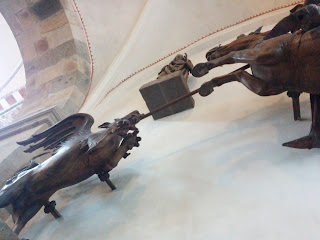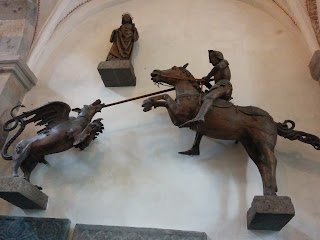One of the recurring sensations in my time in academia is the feeling that there are things with which you never really finish. Today this feeling was brought on by a revision of a transcription of the office for Saint Edmund which I undertook back in 2015, and which forms one of the main pillars for the research of my doctoral thesis.
The offices for the vigil and feast of Saint Edmund Martyr are contained in a manuscript produced at Bury St Edmunds around 1130, together with the first saint-biography of Edmund, Abbo's Passio Eadmundi, and collections of miracles related to Saint Edmund. This manuscript contains the most complete version of the office for the feast of Saint Edmund that has survived, and also the only version of the office for the vigil. For my chapter on Saint Edmund, I have gone into great detail about the chants and readings for the office for the feast day, but now it was time to turn to the office for the vigil instead and get a better overview of what it contains.
The office for the vigil was performed on the eve before the feast of Edmund (November 20), and contains one nocturn of four lessons with responsories in accordance with the monastic model. The chants and lessons all take their material from the miracle collection written down by Herman the Archdeacon around 1080-90. The selection of miracle stories is not wide, as they all focus on one of the most salient episodes in the history of the cult of Saint Edmund, namely the divine punishment of Svein Estrithsson.
The story which Herman wrote down tells of how the Danish king Svein Estrithsson (d.1074/76) invaded England and demanded tribute from the English. He also demanded tribute from the monks at Bury St Edmunds and sought to despoil the riches that had accumulated at the shrine of Saint Edmund Martyr. The monks turned to Edmund for help, and their heavenly ambassador brought divine wrath down upon the Danish king to such a degree that the king exempted Bury from paying tribute. At the time when Herman composed his collection of miracles this story had not been in circulation for many years, but it tied in with another punitive miracle that had been included in the Passio written by Abbo of Fleury in the 980s and so the punishment of the Danish king became one of the most iconic miracles attributed to the merits of Saint Edmund (but performed by God).
Opening of the office for the vigil of Saint Edmund
MS Pierpont Morgan 736, Bury St. Edmunds, c.1130 (photocopy)
MS Pierpont Morgan 736, Bury St. Edmunds, c.1130 (photocopy)
I find the miracle story fascinating, especially in the way it cemented Saint Edmund Martyr's reputation as a guardian of his own shrine and ensured that this reputation would be a recurring feature in later writings at Bury St Edmunds, such as the chronicle of Jocelin of Brakelond from c.1200.
In the coming days I will immerse myself further into the miracles of Saint Edmund, which I left off in 2015 so that I could focus more single-mindedly on the office of the feast itself. To return to this text was a reminder that those things on which you work the most are sometimes the things most likely to stay with you. This feeling of return was perhaps also exacerbated by the fact that back in 2015, the office for the vigil of Saint Edmund was the first text I ever transcribed from a medieval manuscript - or rather, from a printed out photocopied version of the manuscript.
I remember very well the excitement of those summer days in June 2015 where I had a 27-page document to transcribe and make sense of - without any prior experience of transcription. Foolhardy and stupidly optimistic as I sometimes can be, I nonetheless thought that I would be able to do it. And sure enough, I did manage to tackle the text after two intense weeks of work, and I remember feeling overly proud of myself for getting this done.
Today, close to two years later, my experience with transcription is significantly greater, and armed with more experience - and much greater knowledge of the textual corpus in question - I set out to see how much of the transcription work of my 2015 self I had to correct.
It turned out that there was quite a lot to correct, both in terms of things I had misread, things I had failed to understand, things that were close to unintelligible, and also in terms of lack of standardized practices for how to deal with scribal inaccuracies. This was perhaps particularly noticeable in the office for the vigil, since this is the very beginning of the manuscript and the very first text with which I had to try my inexperienced brain.
On the one hand, correcting my mistakes from two years ago gave me a sense of how inexperienced I still am when it comes to manuscript work, even though I have gained a lot more since 2015, and many of the mistakes had the very dirty tinge of the dilettante about them. On the other hand, however, it made me realize just how much I had learned in the two years that had passed, and it also gave me an optimistic sense of all the things I have yet to learn and hopefully will learn as I continue to carve my path through the dense forest that is academia. It is a pleasing thought, and such thoughts are always welcome in the thesis process.



















